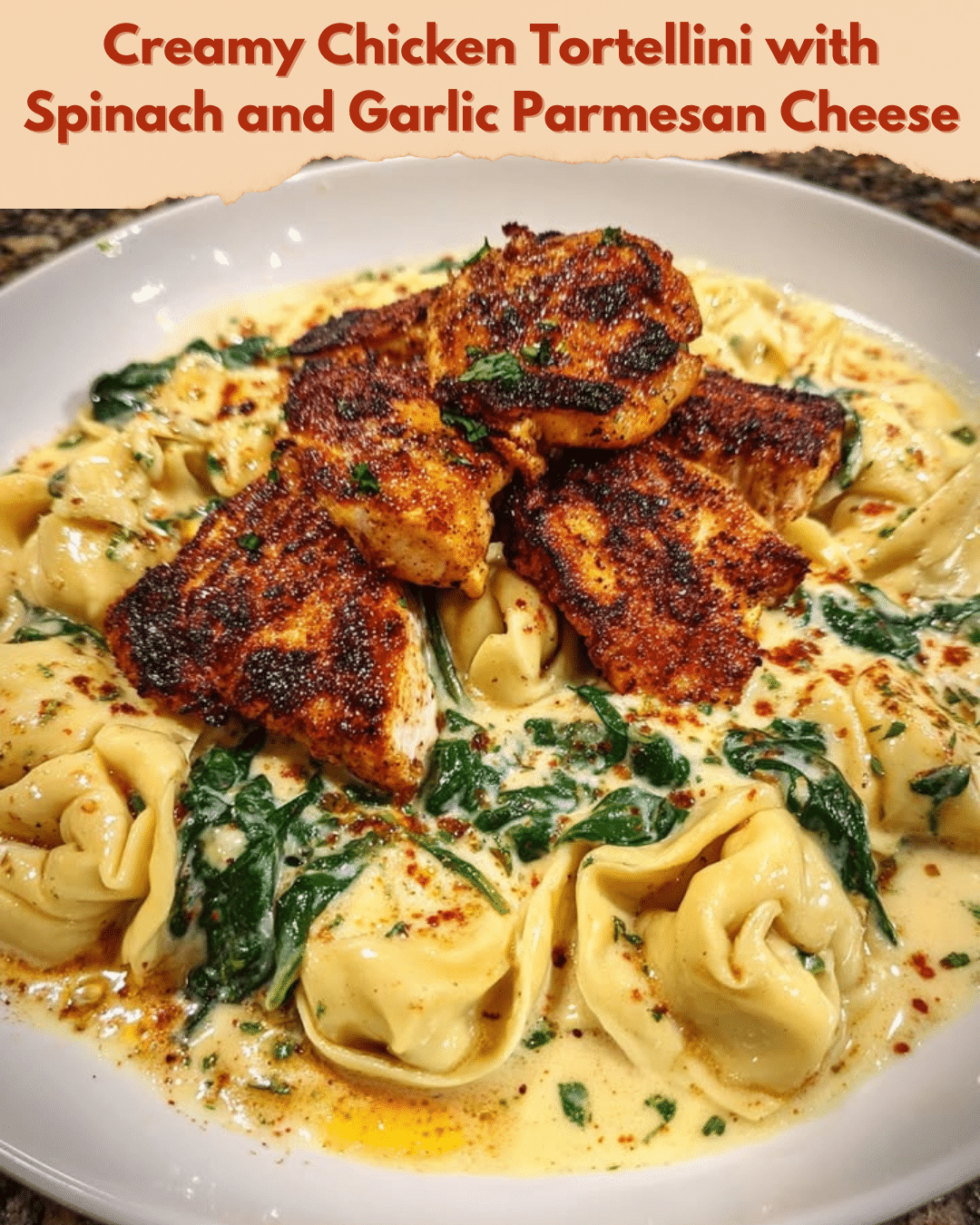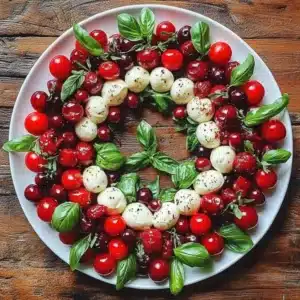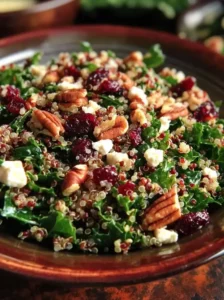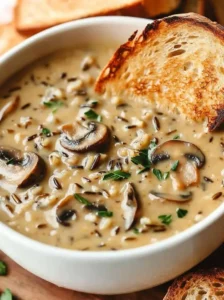Creamy Chicken Tortellini with Spinach and Garlic Parmesan Cheese: An Irresistible Comfort
Get ready to dive into a plate of creamy chicken tortellini with spinach and garlic parmesan cheese, a dish that is not only packed with rich flavors but also simple to make. This pasta recipe brings together the tenderness of chicken with the hearty goodness of tortellini, enhanced by the aromatic blend of spinach and robust garlic Parmesan notes. Perfect for warming both the body and soul, this dish turns a mundane weeknight dinner into a delightful family feast.
Imagine tender, juicy chicken bites enveloped in a creamy sauce that wraps around each tortellini piece, while vibrant spinach leaves strike a delightful contrast. The aroma of garlic mixed with Parmesan cheese wafts through the air, drawing everyone to the dining table. With just 15 minutes of prep time and a short cooking time thereafter, you’ll have a delicious meal that tastes like it took hours to prepare.
Quick Recipe Highlights
- Flavor Profile: This creamy chicken tortellini is rich and savory, with hints of garlic and a beautiful balance of cheese and cream.
- Texture: The tortellini is tender yet firm, while the creamy sauce ensures a velvety mouthfeel, complemented by the slight crunch of fresh spinach.
- Aroma: The delightful garlic and Parmesan fragrance fills the kitchen, promising a satisfying meal.
- Visual Appeal: The dish presents a pleasing palette of creamy whites, vibrant green spinach, and specks of golden-brown chicken.
- Skill Level Needed: Suitable for beginner cooks, requiring basic sautéing and simmering techniques.
- Special Equipment: A deep pan or skillet for even cooking is recommended for this recipe.
Recipe Overview
- Difficulty Level: This recipe is rated easy, perfect for those who are new to cooking or want a simple yet flavorful dish without much fuss.
- Category: Ideal for dinner but versatile enough for a filling lunch option, providing a wholesome meal in one dish.
- Cuisine: Influenced by Italian culinary traditions, this recipe highlights classic flavor profiles associated with delicious pasta dishes.
- Cost: Quite budget-friendly, making use of commonly available ingredients such as chicken, tortellini, spinach, and cheese.
- Season: Creamy pasta dishes like this are comforting choices for autumn and winter but equally enjoyed year-round.
- Occasion: Perfect for family dinners, casual gatherings, or when you need a quick meal that’s sure to impress.
Why You’ll Love This Recipe
The taste and texture of the creamy chicken tortellini are simply unmatched. The cheese-filled tortellini pair beautifully with the succulent chicken pieces, all bathed in a luxurious sauce that makes each bite oozing with flavor. This dish has the potential to become your go-to comfort meal that everyone in the family will adore.
Convenience and the ease of preparation are other key highlights. With a total time of just 35 minutes, it’s perfect for busy weeknights when you want something wholesome yet fast. The ingredients are simple and can be found at your local grocery store, further adding to the appeal of making this dish a regular on your dining table.
Nutritional benefits come primarily from the spinach, which adds a dose of iron and fiber to the meal. The balance of protein from the chicken and carbohydrates from the tortellini ensures this dish is well-rounded, offering both energy and nourishment to keep you going.
On the social side, this dish is a winner for gatherings. The familiar yet indulgent flavors cater to a wide audience, and your friends will appreciate the thoughtfulness that went into preparing such a delightful dish. Whether it’s a casual dinner with friends or a comforting meal for your loved ones, this recipe is bound to be the star.
Finally, the cost-effectiveness and accessibility of the ingredients make it ideal for those on a budget. With chicken and pasta being easy to acquire, you can whip up this luxurious-tasting meal without breaking the bank.
Historical Background and Cultural Significance
The origin story of tortellini is seeped in Italian culture, with its roots tracing back to the Emilia-Romagna region. Legend has it that tortellini were inspired by Venus’s navel, resulting in its iconic shape. This rich cultural tale adds an element of romance and intrigue to the dish.
Culturally, tortellini is a staple in Italian households. Variations have evolved over time, with filling options ranging from meats to cheeses, each version reflecting the local ingredients of its specific region. As pasta became popular worldwide, variations like the creamy chicken tortellini developed, integrating more universal flavors and ingredients.
The evolution of the recipe into its current form was influenced by the increasing popularity of creamy pasta sauces outside Italy. This variation adds a modern twist to the traditional tortellini, maintaining the beloved characteristics of the original while appealing to contemporary tastes.
Regional variations further emphasize the versatility of this dish. In Italian regions, tortellini is typically served in broth or with a light sauce. However, the adaptation to creamy sauces, as discussed here, perfectly suits the Western palate’s love for rich, indulgent dishes.
Ingredient Deep Dive
Let’s talk chicken, a staple protein with significant cultural significance. Known for its versatility, chicken is used in an array of global cuisines. In this tortellini recipe, it’s a key component that adds a filling and satisfying element. Nutritionally, chicken is an excellent source of lean protein and is low in calories compared to other meats.
When selecting chicken, opt for organic or free-range if available. Boneless, skinless chicken breast or thighs work best for this recipe. Store it in a sealed container in the refrigerator and use it within a couple of days for optimal freshness.
Spinach provides a fresh, green element with immense nutritional benefits, packed with vitamins A, C, K, and iron. Cultural tales often emphasize the strength-giving effects of spinach, popularized by characters like Popeye. It adds not only flavor and color but also an extra boost of nutrition.
To keep spinach fresh, store it in a cool refrigerator in a slightly open bag for some airflow. Frozen spinach is a budget-friendly substitute if fresh is unavailable, though it should be well-drained to prevent excess moisture in your dish.
Common Mistakes to Avoid
- Overcooking the chicken can result in dry, tough pieces. Always monitor the cooking times and use medium heat.
- Using too much salt. The cheese itself is salty, so taste before adding extra to maintain flavor balance.
- Skimping on the sauce will leave the dish dry. Ensure there’s enough liquid for a creamy result.
- Adding spinach too early can lead to it becoming soggy. Add it at the end to retain its vibrant color and texture.
- Overcooking the tortellini as it continues cooking slightly in the sauce — aim for al dente.
- Neglecting to stir occasionally during cooking — this prevents sticking and ensures even cooking throughout.
- Undercooking the garlic will yield a raw, pungent taste rather than the subtle sweetness achieved from proper sautéing.
- Forgetting to reserve pasta water. It can be used to adjust the sauce’s consistency.
Essential Techniques
To master the sauté, maintain even heat and stir frequently to brown without burning the ingredients. This releases the full flavor potential of garlic and chicken, forming a flavor base for the sauce.
Craft the perfect creamy sauce by gradually incorporating the cream into the skillet over low heat. Doing so prevents breaking, ensuring a smooth, homogenized consistency that clings to the tortellini for a luxurious coating.
Using freshly grated Parmesan cheese enhances both flavor and texture, as pre-grated options may contain anti-caking agents that inhibit melting.
Stirring the tortellini into the sauce ensures that each piece is well-coated and flavorful, a visual cue of success being the tortellini engulfed in a glossy, creamy cloak.
Pro Tips for Perfect Creamy Chicken Tortellini
Balance flavors with a splash of lemon juice at the end to brighten up the dish and balance the richness of the cream and cheese.
For a deeper flavor, consider caramelizing your onions before adding other ingredients, which will add a subtle sweetness and complexity.
When cooking the chicken, ensure the skillet is not overcrowded, which will prevent steaming and allow for proper browning and flavor development.
To infuse extra richness, you can deglaze the pan with a splash of white wine before adding the cream, heightened with a distinct yet delicate wine flavor.
Consider using a mix of parmesan and pecorino cheeses for a varied flavor profile in the sauce. Pecorino’s tangy edge beautifully complements Parmesan’s nutty profile.
Adding a pinch of nutmeg to the sauce can elevate the dish with a warm, sweet note characteristic of classic Italian cream sauces.
If you’re serving guests, consider preparing the dish just before their arrival to serve it freshly cooked while retaining the vibrant texture of all ingredients involved.
Variations and Adaptations
Regional variations exist in Italy where tortellini is often served in a light broth instead of creamy sauce. You can replicate these variations by serving the tortellini in hearty chicken or vegetable broth for a lighter meal.
For seasonal adaptations, pair the tortellini with roasted butternut squash or zucchini, introducing autumn or summer flavors that complement the base of the dish.
Adjust the recipe for dietary needs, such as using gluten-free tortellini or swapping the cream for a plant-based option to accommodate lactose intolerance or dietary preferences.
Exploring flavor variations by adding sun-dried tomatoes or a hint of pesto can introduce new flavor notes, adding complexity without diverting from the dish’s essence.
For a different texture, consider tossing in crispy fried shallots or toasted pine nuts before serving, adding a satisfying crunch to contrast with the creamy sauce.
Presentation alternatives encompass garnishing with freshly grated lemon zest or a sprinkle of microgreens, which introduces a pop of color and freshness.
Serving and Presentation Guide
Use large, shallow bowls for an elegant presentation that showcases the dish’s elements. Allow room for the tortellini to be displayed without crowding.
Garnishing with a sprinkle of freshly chopped parsley adds color contrast and a fresh herbal note, acting as a visually appealing counterbalance to the dish’s richness.
Traditional accompaniments like a simple green salad or crusty bread are ideal companions, offering texture contrasts while helping to soak up the delectable sauce.
Modern serving suggestions encourage individual plates presentation, ensuring even distribution of chicken and tortellini pieces for equal servings per guest.
Temperature considerations are essential in serving this dish immediately after preparation, as the sauce’s texture and consistency are best freshly made.
Practice portion control by determining serving size prior, usually amounting to about one cup of tortellini per guest as a main course.
Wine and Beverage Pairing
A crisp Chardonnay with its buttery finish complements the creamy sauce perfectly, enhancing the overall dining experience without overwhelming the delicate flavors.
Non-alcoholic alternatives such as a sparkling water infused with lemon and herbs refresh the palate, offering a clean counterbalance to the richness of the dish.
If coffee or tea pairings apply, a lightly roasted espresso or green tea with subtle notes would work as a pleasant follow-up, enhancing the meal’s culmination.
Temperature considerations are key; serving beverages slightly chilled maintains their refreshing quality against the warmth of the tortellini dish.
Serving suggestions include presenting drinks in clear glasses allowing guests to appreciate colors and aromas, naturally enhancing the overall dining ambiance.
Storage and Shelf Life
Store any leftovers in an airtight container to prevent sauce drying and ensure freshness protection for up to four days in the refrigerator.
Pay attention to temperature requirements, ensuring the dish cools before sealing and refrigerating to maintain optimal texture and safety.
Container recommendations aim for shallow, wide containers allowing you to spread out the tortellini ensuring even cooling and reheating.
Be vigilant for signs of spoilage, such as off odors or mold, before consuming prepared meals. These indicate that the meal is past safe storage time.
Reheating instructions guide you to gently warm over medium heat on the stove, adding a splash of milk or water to revive the sauce’s creamy consistency.
Freezing guidelines suggest avoiding freezing due to potential textural changes in cream-based dishes; preparation as needed yields the best results.
Make Ahead Strategies
Plan the prep timeline to chop ingredients and prepare the sauce up to a day in advance, storing each component separately until cooking time.
Store components between steps by refrigerating cooked chicken and the sauce in separate sealed containers for freshness retention.
Assess the quality impact of making ahead, noting some changes in texture may occur but often can be revived during final preparation.
Assembly tips suggest combining all elements just before serving to ensure fresh spinach texture and vibrant color remain intact.
Reheat with guidelines recommending stovetop warming over low heat to bring back warmth evenly without altering texture significantly.
Ensure fresh element additions, like incorporating spinach only during final reheating to maintain its included fresh, appealing texture.
Scaling Instructions
Halving the recipe is straightforward; simply divide ingredients by half to accommodate smaller party sizes without difficulty scaling down cooking times.
Doubling or tripling involves proportional ingredient increases, ensuring to use larger pans for even cooking and efficient sauce incorporation.
Equipment adjustments might entail scaling the pan or skillet size when scaling up, ensuring ample cooking surface area to avoid overcrowding.
Timing modifications consider increased cooking duration when handling greater volumes, particularly for chicken browning and sauce thickening.
Consider storage considerations by planning space ahead of time when scaling recipes, ensuring adequate storage for prepared components.
Nutritional Deep Dive
Starting with a macro breakdown, note that this dish offers balanced nutrients with ample protein from chicken, carbohydrates from tortellini and healthy fats in the sauce.
Micronutrient analysis reveals valuable vitamins and minerals, particularly from spinach and cheese, contributing to an overall nutrient-rich meal.
Highlight health benefits attributed to spinach’s iron content and chicken’s lean protein, both of which support muscle maintenance and energy.
Dietary considerations suggest incorporating whole-grain tortellini if desired, to enhance fiber content, especially useful for those focused on balanced meals.
Delve into portion analysis, aiming for roughly a cup of tortellini serving balancing nutritional value without excessive caloric intake.
Support weight management tips by emphasizing portion monitoring and incorporating ample vegetables, balancing taste and dietary goals effectively.
Dietary Adaptations
To accommodate gluten-free preferences, use gluten-free pasta alternatives readily available to keep this recipe in line with dietary restrictions.
Dairy-free modifications involve choosing plant-based milk and cheese substitutes, ensuring a creamy texture is achieved without common allergens.
Consider vegan options by omitting chicken and using plant-based alternative proteins, with nutritional yeast adding a cheesy flavor accent.
For low-carb meals, choose keto-friendly pasta alternatives and incorporate more vegetables, maintaining flavor depth and texture sensibility.
Adapting for a paleo diet includes focusing on vegetable and protein components while exploring alternative creaming methods, like coconut milk.
Low-FODMAP considerations focus on garlic-infused oil sans solids to retain flavor without triggering sensitivities, maintaining dish enjoyment.
Other specific diets address lifestyle choices and personal adjustments based on component alterability, showcasing recipe diversity and adaptability.
Troubleshooting Guide
Tackling texture issues involves identifying overcooking root causes, aiming for al dente consistency in pasta and ensuring chicken remains juicy.
Balance flavor approaches ensure ingredients harmonize, mindful of seasoning adjustments to highlight natural components without overpowering.
Temperature problems may arise from time missynchronization; reheating cautiously and covering while maintaining moisture revives optimal serving temps.
Address equipment challenges by ensuring even heat distribution during cooking and utilizing appropriate utensil sizes for consistent outcomes.
Ingredient substitutions empower adaptability within recipe guidelines, exploring enhancements or regulator swapping based personal preference.
Timing concerns focus on staggered cooking phase approaches, coordinating prep and cook times for synchronizing dish completion while catering to streamlined service continuity.
Recipe Success Stories
Community feedback illuminates this creamy chicken tortellini as a household favorite, providing cherished moments and culinary triumphs amidst shared dinners.
Variation successes emphasize flexibility, with members sharing adaptations like adding roasted vegetables or switching to plant-based versions with continued satisfaction.
Adaptation stories inspire, highlighting opportunities recipe keenly offers for embracing individual creativity, adjusting sauce elements, and ingredient essentials.
Reader suggestions contribute unique twists and shared personal tips, expanding recipe horizons with added specifics and insights from communal members.
Photography tips from home cooks showcase innovative plating, resulting in visually appealing displays that entice visual storytelling alongside recipe execution.
Frequently Asked Questions
- Can I use pre-cooked chicken in this recipe? Yes, you can. Make sure it’s well-seasoned and add it during the sauce integration step to prevent overcooking.
- How can I make the dish more flavorful? Incorporate additional herbs like thyme or basil, or experiment with a hint of white wine for depth.
- What should I use if fresh spinach is unavailable? Frozen spinach can be a substitute, but ensure excess moisture is removed before adding.
- Can this be made with frozen tortellini? Absolutely. Just adjust boiling time per package instructions before adding to the sauce.
- Is there a dairy-free option? Using plant-based cream and cheese alternatives effectively maintains creaminess without dairy.
- How should I adjust seasoning for children? Reduce the amount of garlic and red pepper flakes to cater to milder taste preferences.
- What wine pairs best with this dish? A light-to-medium white wine, such as Chardonnay or Sauvignon Blanc, complements the creamy sauce.
- Can leftovers be frozen? Cream-based sauces may change texture when frozen, so refrigerating leftovers and consuming within four days is recommended.
- What’s a good side dish for this recipe? Garlic bread or a simple arugula salad provide complementary contrast notes to this pasta dish.
- Can I prepare this in advance? Parts of the dish, such as the sauce or chicken, can be made ahead, but combine and heat ingredients just before serving for optimal quality.
- Is there a way to cut down on the richness? Replace some of the cream with chicken broth to reduce richness while maintaining flavor.
- Can I use another type of cheese? Certainly, try pecorino for a sharper flavor or mozzarella for creamier texture pairing.
Additional Resources
Explore related recipes that incorporate variations, expanding culinary horizons with dishes like sun-dried tomato pesto tortellini or creamy mushroom pasta.
Susceptible technique guides lead to improved skill acquisition, providing insights into mastering fundamental cooking methods like sautéing and simmering.
Discover ingredient information that highlights storied histories, nutritional benefits, and effective storage methods, fostering appreciation for enriched kitchen craft.
Enrich recipes involving complementary ingredient inclusion, benefiting from cumulative experience in culinary experimentations and shared knowledgeable community.
Recommendations on seasonal adjustments encourage creativity, adapting recipes to showcase fresh, regional produce that enhances outcome authenticity, ensuring delightful sensory dining experiences.
Print
Creamy Chicken Tortellini with Spinach and Garlic Parmesan Cheese
Description
A flavorful and comforting dish combining tender chicken, cheese-filled tortellini, fresh spinach, and a creamy garlic parmesan sauce.
Ingredients
For the Crust:
- 2 cups cheese tortellini
- 1 pound chicken breast, diced
- 2 cups fresh spinach
- 3 cloves garlic, minced
- 1 cup heavy cream
- 1 cup grated parmesan cheese
- 2 tablespoons olive oil
- Salt and pepper to taste
Instructions
1. Prepare the Crust:
- Cook the tortellini according to package instructions, then drain and set aside.
- In a large skillet, heat olive oil over medium heat. Add the diced chicken and cook until browned and cooked through.
- Add the minced garlic to the skillet and sauté for 1-2 minutes until fragrant. Stir in the heavy cream and bring to a simmer. Add the parmesan cheese, stirring until melted and the sauce thickens.
- Mix in the spinach and cooked tortellini, stirring gently until the spinach wilts. Season with salt and pepper to taste.
- Serve warm, garnished with additional parmesan if desired.
Notes
You can customize the seasonings to taste.





